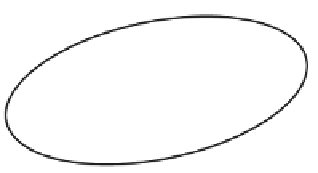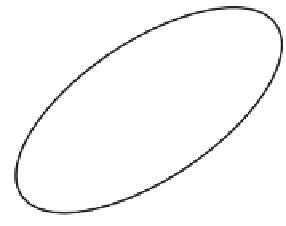Graphics Reference
In-Depth Information
Motion can also be generated by modifying the other parameters of the implicit surface. The
weights of the different implicit primitives can be manipulated to effect bulging and otherwise control
the size of an implicit object. A simple blend between objects can be performed by decreasing the
weight of one implicit object from 1 to 0 while increasing another implicit object's weight from
0 to 1. The density function of the implicit objects can also be controlled to produce similar shape defor-
mation effects. Modifying the central element of the implicit is also useful. The elongation of the defin-
ing axes of the ellipsoidal implicit can produce squashing and stretching effects. The orientation and
length of the axes can be tied to the velocity and acceleration attributes of the implicit object.
12.1.3
Collision detection
Implicitly defined objects, because they are implemented using an implicit function, lend themselves to
collision detection. Sample points on the surface of one object can be tested for penetration with an
implicit object by merely evaluating the implicit function at those points in space (
Figure 12.4
)
. Of
course, the effectiveness of this method is dependent on the density and distribution of the sample
points on the first object. If a polyhedral object can be satisfactorily approximated by one or more
implicit surface primitives, then these can be used to detect collisions of other polyhedral objects.
Bounding spheres are a simple example of this, but more complex implicits can be used for more pre-
cise fitting.
Because implicit functions can be used effectively in testing for collisions, they can be used to test
for collisions between polyhedral objects if they can fit reasonably well on the surface of the polyhedra
(
Figure 12.5
). Of course, the effectiveness of the technique is dependent on the accuracy with which the
implicit surfaces approximate the polyhedral surface.
12.1.4
Deforming the implicit surface as a result of collision
Cani has developed a technique to compute the deformation of colliding implicit surfaces [
3
]
[
6
][
7
]
(published under the name of Gascuel). This technique first detects the collision of two implicit sur-
faces by testing sample points on the surface of one object against the implicit function of the other, as
previously described. The overlap of the areas of influence of the two implicit objects is called the
FIGURE 12.4
Point samples used to test for collisions.





















Search WWH ::

Custom Search